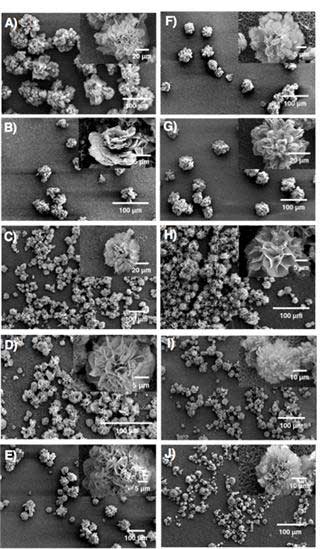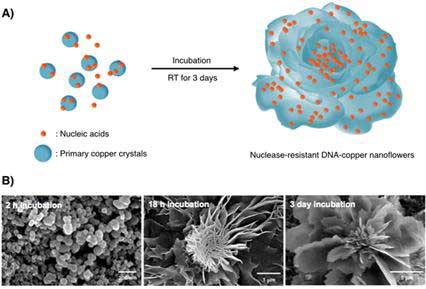| Posted: Apr 17, 2017 |
Nuclease-resistant hybrid nanoflowers
(Nanowerk News) An eco-friendly method to synthesize DNA-copper nanoflowers with high load efficiencies, low cytotoxicity, and strong resistance against nucleases has been developed by Professor Hyun Gyu Park in the Department of Chemical and Biomolecular Engineering and his collaborators (Journal of Materials Chemistry B, "A simple and eco-friendly one-pot synthesis of nuclease-resistant DNA–inorganic hybrid nanoflowers").
|
|
The research team successfully formed a flower-shaped nanostructure in an eco-friendly condition by using interactions between copper ions and DNA containing amide and amine groups. The resulting nanoflowers exhibit high DNA loading capacities in addition to low cytotoxicity.
|
 |
| SEM images show the effect of the DNA sequence and length of the formation of DNA-nanoflowers. (A) dNTPs (100 mM), (B) adenine-rich ssDNA (0.25 mM), (C) thymine-rich ssDNA (0.25 mM), (D) guanine-rich ssDNA (0.25 mM), (E) cytosine-rich ssDNA (0.25 mM), (F) A-T dsDNA (51 bp; 0.25 mM), (G) G-C dsDNA (51 bp; 0.25 mM), (H) PCR amplicon (200 bp; 600 nM), (I) plasmid DNA (5420 bp; 20 nM), and (J) genomic DNA (4857 kbp; 10 pM). (Image: KAIST)
|
|
Flower-shaped nanocrystals called nanoflowers have gained attention for their distinct features of high surface roughness and high surface area to volume ratios. The nanoflowers have been used in many areas including catalysis, electronics, and analytical chemistry.
|
|
Of late, research breakthroughs were made in the generation of hybrid inorganic-organic nanoflowers containing various enzymes as organic components. The hybridization with inorganic materials greatly enhanced enzymatic activity, stability, and durability compared to the corresponding free enzymes.
|
|
Generally, the formation of protein nanocrystals requires high heat treatment so it has limitations for achieving the high loading capacities of intact DNA.
|
|
The research team addressed the issue, focusing on the fact that nucleic acids with well-defined structures and selective recognition properties also contain amide and amine groups in their nucleobases. They proved that flower-like structures could be formed by using nucleic acids as a synthetic template, which paved the way to synthesize the hybrid nanoflowers containing DNA as an organic component in an eco-friendly condition.
|
|
The team also confirmed that this synthetic method can be universally applied to any DNA sequences containing amide and amine groups. They said their approach is quite unique considering that the majority of previous works focused on the utilization of DNA as a linker to assemble the nanomaterials. They said the method has several advantageous features. First, the 'green' synthetic procedure doesn't involve any toxic chemicals, and shows low cytotoxicity and strong resistance against nucleases. Second, the obtained nanoflowers exhibit exceptionally high DNA loading capacities.
|
 |
| This is a schematic illustration. (A) Schematic illustration of the formation of nuclease-resistant DNA-inorganic nanoflowers. (B) SEM images showing time-dependent growth of DNA-nanoflower. (Image: KAIST)
|
|
Above all, such superior features of hybrid nanoflowers enabled the sensitive detection of various molecules including phenol, hydrogen peroxide, and glucose. DNA-copper nanoflowers showed even higher peroxidase activity than those of protein-copper nanoflowers, which may be due to the larger surface area of the flower- shaped structures, creating a greater chance for applying them in the field of sensing of detection of hydrogen peroxide.
|
|
The research team expects that their research will create diverse applications in many areas including biosensors and will be further applied into therapeutic applications.
|
|
Professor Park said, "The inorganic component in the hybrid nanoflowers not only exhibits low cytotoxicity, but also protects the encapsulated DNA from being cleaved by endonuclease enzymes. Using this feature, the nanostructure will be applied into developing gene therapeutic carriers."
|


